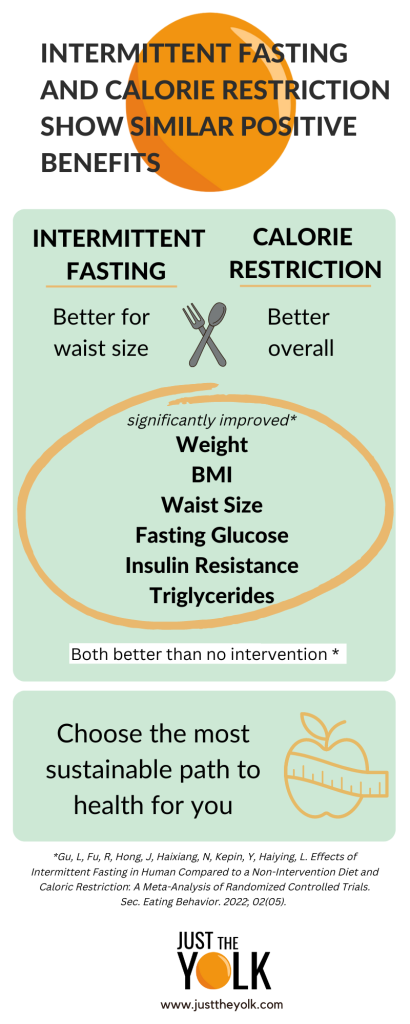This is a brief summary of the following research study:
Gu, L, Fu, R, Hong, J, Haixiang, N, Kepin, Y, Haiying, L. Effects of Intermittent Fasting in Human Compared to a Non-Intervention Diet and Caloric Restriction: A Meta-Analysis of Randomized Controlled Trials. Sec. Eating Behavior. 2022; 02(05). https://doi.org/10.3389/fnut.2022.871682
The Yolk
- Study examined Intermittent Fasting vs. Calorie Restriction vs. No Intervention
- Gathered results from 43 research studies – 2,483 total participants
- Many different intermittent fasting types included
- Categories measured:
- Weight
- BMI
- Waist circumference
- Fasting glucose
- Triglycerides
- Intermittent Fasting and Calorie Restriction had similar positive results
- Intermittent fasting showed more change in waist circumference than Calorie Restriction
- Intermittent fasting did not show significant results in fasting glucose levels BUT better insulin resistance (less likely to get diabetes)
- Intermittent Fasting improved in all categories significantly better than No Intervention
- Fasting effects were not consistent among men and women, and overweight and obese
Perspective
- Other factors to consider here – how much exercise or the different types of fasting
- 43 studies with significantly consistent results is the best we can do
- Interestingly, intermittent fasting appears to be similar to the calorie restriction approach as far as effects on health
- Intermittent fasting may be easier to sustain
- Most basic fasting idea – don’t eat after dinner until breakfast time
- Most common – eat, for example, from 11am-7pm and fast for the other 16 hours
- Restricting calories may be difficult and feel like a lot of work but would be better for someone who cannot wait 16 hours to eat – finding the right amount is helpful
- Choose only the sustainable realistic path for yourself on your way to good health
Resources & Research


